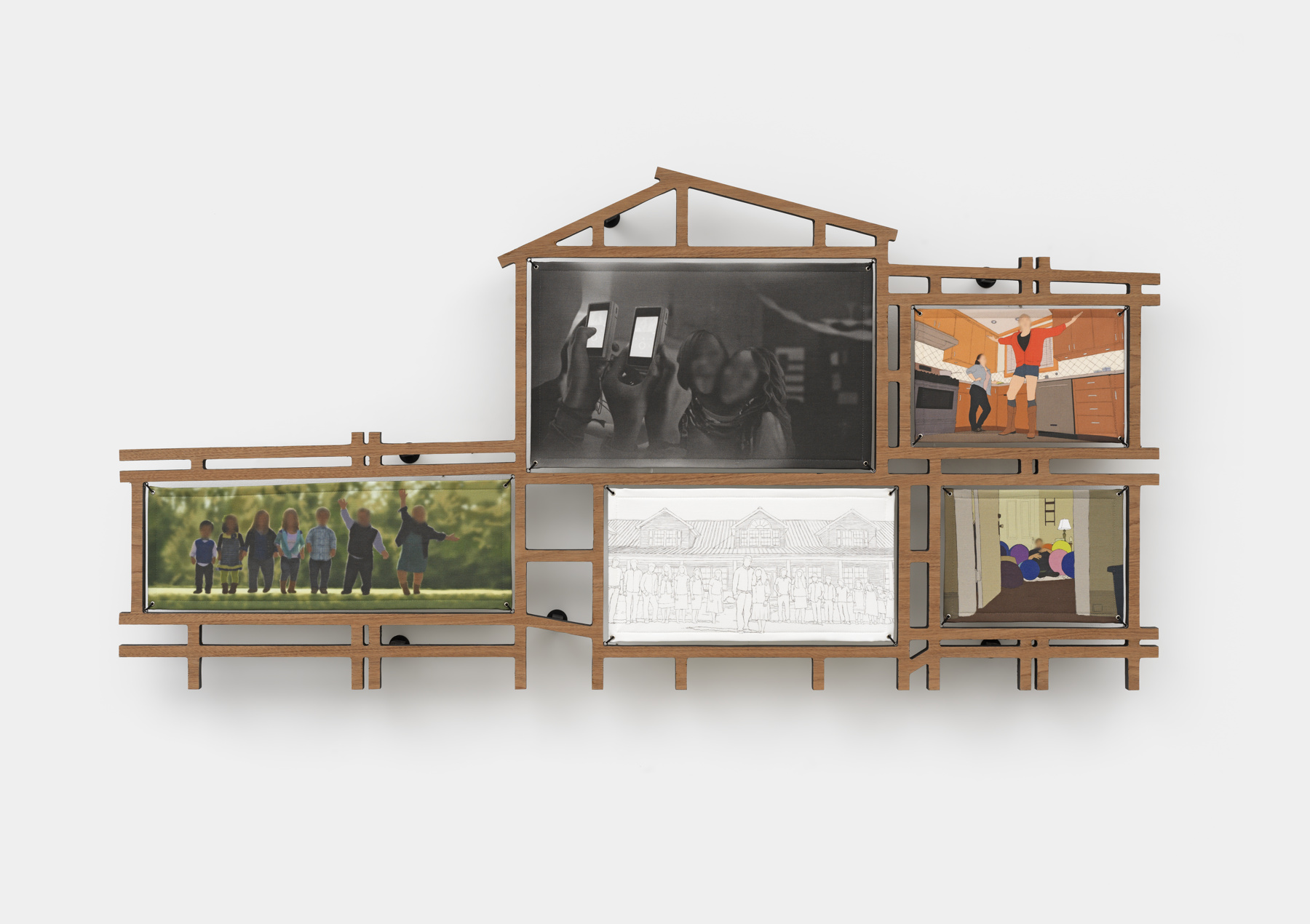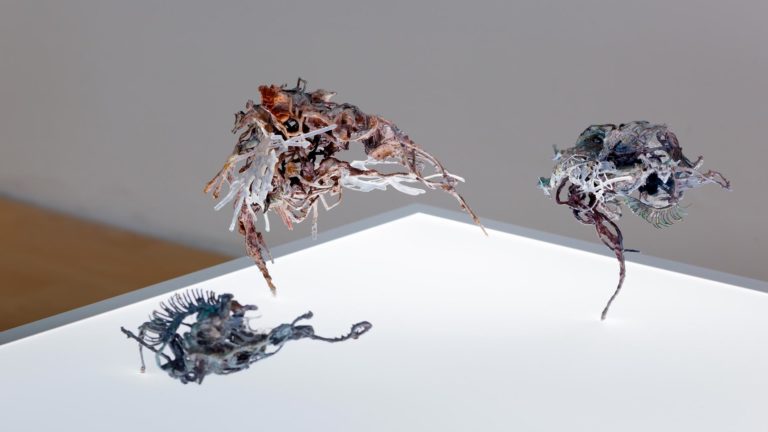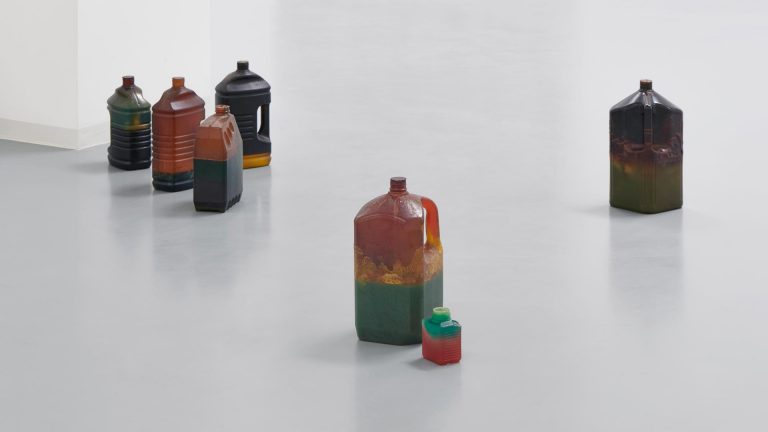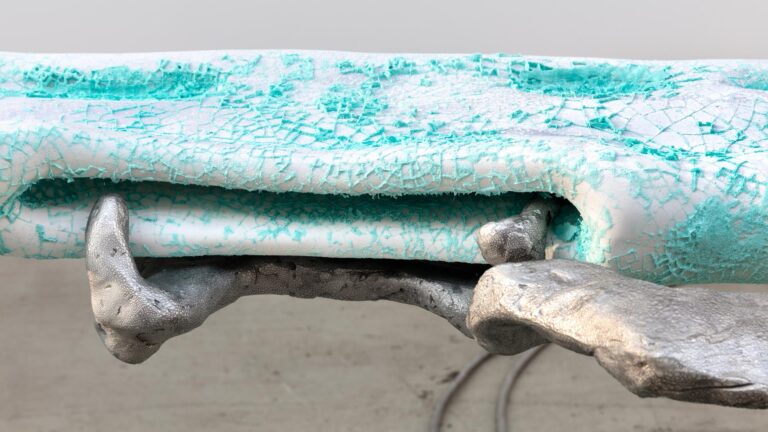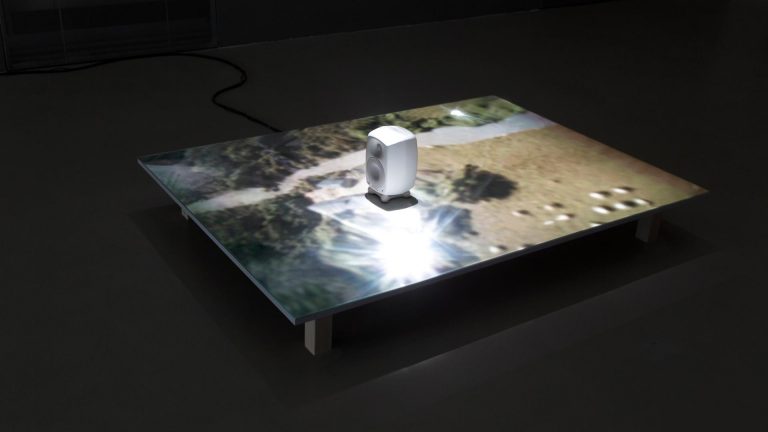Artist: Andrea Crespo
Exhibition title: Step Right Up
Venue: Kraupa-Tuskany Zeidler, Berlin, Germany
Date: January 26 – March 2, 2019
Photography: def_image / all images copyright and courtesy of the artist and Kraupa-Tuskany Zeidler, Berlin
There’s an elephant in the room and no one is talking. Our imaginaries are haunted by specters of old, our sensibilities shaped by them as much as the backlash against them. Yet in many ways, they have re-turned, ‘reconfigured’ and adapted for our times (Stulman Dennett, 141). I speak of ‘freak shows’ and the artificial historical figure they’ve created through entertainment practices, ‘frames of mind’, and ‘styled presentations’: the offensively termed ‘freak’ (Bogdan, 35). Not the ‘freak of nature’, but the ‘freak of culture’; as this pejorative slur is not apt to describe a single human being on this planet, but rather a historical figure that is projected unto certain people who are far-flung along diverse axes of bodily, psychological, and behavioral differences (Garland Thomson, Freakery, xviii). Howev-er, such language is not often used in shows of recent decades, save for a few of its manifestations. Indeed, what has made them fit comfortably within contemporary mediascapes is their often sanitized and humanistic inflection; the way they blend the virtuous with the vicious.
But how did we, particularly in the United States, where many of these modern practices were scaled for the masses, arrive at this point? After all, the ‘freak shows’ of the 19th and early 20th centu-ry had gone nearly extinct by the Second World War. The public had decided, by this time, that such a form of entertainment was in ‘bad taste’ if not blatantly immoral in spite of the industry’s claims that the shows had educational and moral value (which made them, in a sense, precursors of today’s ‘edutainment’). The concurrent adoption of broadcast television on a mass level only served to expedite the ‘freak show’s’ decline in cultural prominence. Ultimately, as a result of these shifts in public opinion and technology, dime museums shuttered across the country and traveling circuses amended their shows to exclude ‘freak shows’ (Garland Thomson, Introduction, 11).
But that wasn’t the end of it; the United States and much of the Anglo-sphere later decided that the show must go on. Television, though it supplanted the old shows with alternative and more convenient forms of entertainment, broke the hiatus during the last decades of the 20th century. As a medium, it served to defamiliarize many of the display practices present in older shows, recontextualizing them in ways which would make the public more at ease consuming them.
The first of these new display practices to emerge was the tabloid talk show. Though it existed as early as the 1960s, it wasn’t until the mid-1980s and through the 1990s that talk shows began to fea-ture guests whose physiologies and, in particular, psychologies were the loci of interest. Such guests included people with deviant sexualities, unusual lifestyles, strange behaviors, and the like. Though occasionally people who are physiologically different are featured on these programs, a great deal of them is considered so as a result of choices they made through body modification and plastic surgery. This focus on psychological and behavioral rather than physical differences is one way the talk show differs from earlier shows. However, it replicates the dime museum in its educational mode of presenta-tion, in how it sets up an ‘expert’ or lecturer that mediates between the guest(s) of interest and the audience. The role of expert, lecturer, and the interviewer is filled by people such as Oprah Winfrey, Dr. Phil, Maury, and Jerry Springer; names many of us still remember despite the decline of the talk show in recent times (Stulman Dennett, 142).
During the talk show’s heyday, those who were born physically different, as well as those who underwent drastic forms of bodily modification were to be often found appearing on medical documentaries. Medi-cal documentaries were a more austere and educational form than the talk-shows, playing into people’s morbid curiosities with clinical coolness and detachment. The main stage of this form was the surgi-cal theatre, in which all sorts of procedures were performed before audiences of millions. While much attention is directed towards the patients (very often conjoined twins being separated or transsexuals receiving ‘sex-change’ procedures), a lot of it is channeled towards the technological refinement of the stage itself as well as its supporting actors: physicians (Clark and Myser, 339). The medical doc-umentary continues to exist today and many of its tropes have migrated to reality shows centered around plastic surgery as well as other forms of edutainment.
This brings us to our next attraction: the reality show. This genre paved the way for the intrusion of audiences into the domestic spheres and quotidian lives of people and families of interest. The real-ity show, by its very nature, seemed to justify prolonged staring over multiple episodes and seasons; with some families being followed for over a decade. Starting in the 1990s, but mostly the 2000s and 2010s, the reality show and its influence on other forms of edutainment has created a world in which one can catch up with the minute details of the lives of transgender teens, families of little peo-ple, conjoined twins, the dangerously obese, and others. Running parallel to these sorts of programs are series that focus on people with bizarre addictions, strange behaviors, and psychiatric disorders; with different people in every episode. These are, in many ways, the most degrading, but this is not to say that all of reality television is insidious. While many of these shows are clearly pornographic or derisive in intent, some have strongly humanizing valences to the extent that they can be considered forms of disability activism, however fraught with issues and contradictions they might be. It can be argued that these programs, as well as the others, discussed, allow people to ‘use the way they look, the way we look at them, and what they say about it to ask the public to think differently about people like them’ (Garland Thomson, Staring, 193).
Reality television’s run has lasted through the 2010s, but its prominence has steadily waned over the decade as the Internet pushes television further into hindsight. While many televisual forms have come to have second lives on streaming platforms, the Internet has brought about innovations of its own such as viral memes and videos that are based on appropriated and/or original content: the new sites of display. What is unique about the viral online forms is the extremes of violence they tend toward; to the producers of this content, everything becomes fodder for ridicule and comical effect. Many of the violently humorous memes become ‘running jokes’ that mutate as they spread and are modified along the way, even using images of different people with the same disability or difference but applying the same set of motifs, catch-phrases, and punch-lines. To make matters worse, many become unwitting subjects of this media without their consent and have their image taken for nefarious purposes. Even the more inspirationally-minded memes fail to be inspirational without also denigrating the persons depicted. The irony in these high-tech online practices is that they are a reversion to antiquated pre-Christian, pre-scientific, and pre-humanistic practices of display. They are more like Western pagan representa-tions of the ‘monstrous’ than any of the other forms that have been popular in recent centuries. Unlike the previously discussed forms, they do very little to educate or even attenuate violence; bringing us back full-circle, in a sense, toward an ‘ancient comic tradition’ that seeks little more than frivol-ity and amusement in the ‘grotesque’ (Semonin, 79-80). Needless to say, as in ancient traditions, our networked side shows accomplish little else but the debasement of the human person.
The persistence of all of the above practices into the present, even in an age of ‘political correct-ness’, speaks to deeply ingrained cultural habits, if not about humanity itself. Perhaps it speaks to our human impulse to stare, and to go beyond looking, at people who break from expectations in body, mind, and behavior; an exchange which can be an opportunity to relate and build meaning (Garland Thom-son, Staring, 3,14). At their lowest, our stares and consumption of ‘freakishness’ reveal our basest and most carnal tendencies to stare in order to gain illicit pleasure or to be cruel toward those we deem less worthy of dignity. But perhaps in spite of that, they reveal our desire to see humanity in all people, to seek the image of God in every living person in spite of their bodily or psychological fallenness.
– Andrea Crespo
Andrea Crespo (b. 1993) lives and works in New York. In his recent practice, Andrea Crespo examines the persistent legacy of spectacularization of certain variations of human experiences. Crespo investigates complex cultural and historical narratives surrounding errant forms of psychological and bodily being. Identity, or errors of identity, have encompassed Crespo’s practice, though he has also focused on the connections of psychopathological realities, cultural formations and digital communities associated with them. His body of works range across video and sound installations, prints, and drawings.
Crespo’s recent solo exhibitions were held at Kraupa-Tuskany Zeidler, Berlin; Downs & Ross, New York; MIT List Visual Arts Center, Cambridge, MA; New Museum/Rhizome, online; Swiss Institute/Contemporary Art, New York; vdrome.org, online; Hester, New York. His works were also shown at Fondation Louis Vuit-ton, Paris; The Whitney Museum of American Art, New York; MINI/ Goethe-Institut, New York; MAXXI, Rome; The Kitchen, New York; Zabludowicz Collection, London; Musée Éspace Arlaud, Lausanne; LUMA/ Westbau, Zürich; Associazone Barriera, Turin; Serpentine Galleries, London; Institute of Contemporary Arts, Lon-don; The Fridericianum, Kassel.
Andrea Crespo, Step Right Up, 2019, exhibition view, Kraupa-Tuskany Zeidler, Berlin
Andrea Crespo, Step Right Up, 2019, exhibition view, Kraupa-Tuskany Zeidler, Berlin
Andrea Crespo, Step Right Up, 2019, exhibition view, Kraupa-Tuskany Zeidler, Berlin
Andrea Crespo, Step Right Up, 2019, exhibition view, Kraupa-Tuskany Zeidler, Berlin
Andrea Crespo, Step Right Up, 2019, exhibition view, Kraupa-Tuskany Zeidler, Berlin
Andrea Crespo, Step Right Up, 2019, exhibition view, Kraupa-Tuskany Zeidler, Berlin
Andrea Crespo, Step Right Up, 2019, exhibition view, Kraupa-Tuskany Zeidler, Berlin
Andrea Crespo, Tar and Feather, 2018, mahogany veneered plywood, digital prints on linen cotton canvas, metal eyelets, metal screw hooks, cord, metal brackets, screws, 97.46 x 152.4 x 7.62 cm, Photo: Gunter Lepkowski
Andrea Crespo, Tar and Feather, 2018, mahogany veneered plywood, digital prints on linen cotton canvas, metal eyelets, metal screw hooks, cord, metal brackets, screws, 97.46 x 152.4 x 7.62 cm, Photo: Gunter Lepkowski
Andrea Crespo, Inspo, 2018, mahogany veneered plywood, digital prints on linen cotton canvas, metal eyelets, metal screw hooks, cord, metal brackets, screws, 115.87 x 152.4 x 7.62 cm, Photo: Gunter Lepkowski
Andrea Crespo, Cutting Edge, 2018, mahogany veneered plywood, digital prints on linen cotton canvas, metal eyelets, metal screw hooks, cord, metal brackets, screws, 84.2 x 152.4 x 7.62 cm, Photo: Gunter Lepkowski
Andrea Crespo, Cutting Edge, 2018, mahogany veneered plywood, digital prints on linen cotton canvas, metal eyelets, metal screw hooks, cord, metal brackets, screws, 84.2 x 152.4 x 7.62 cm, Photo: Gunter Lepkowski
Andrea Crespo, Pediatainment, 2018, mahogany veneered plywood, digital prints on linen cotton canvas, metal eyelets, metal screw hooks, cord, metal brackets, screws, 52.45 x 152.4 x 7.62 cm, Photo: Gunter Lepkowski
Andrea Crespo, Reality in Transit, 2018, mahogany veneered plywood, digital prints on linen cotton canvas, metal eyelets, metal screw hooks, cord, metal brackets, screws, 71.68 x 152.4 x 7.62 cm, Photo: Gunter Lepkowski
Andrea Crespo, Reality in Transit, 2018, mahogany veneered plywood, digital prints on linen cotton canvas, metal eyelets, metal screw hooks, cord, metal brackets, screws, 71.68 x 152.4 x 7.62 cm, Photo: Gunter Lepkowski
Andrea Crespo, Transfxion, 2018, mahogany veneered plywood, digital prints on linen cotton canvas, metal eyelets, metal screw hooks, cord, metal brackets, screws, 81.84 x 152.4 x 7.62 cm, Photo: Gunter Lepkowski
Andrea Crespo, Out of Orbit, 2018, mahogany veneered plywood, digital prints on linen cotton canvas, metal eyelets, metal screw hooks, cord, metal brackets, screws, 99.06 x 152.4 x 7.62 cm, Photo: Gunter Lepkowski
Andrea Crespo, Center Stage, 2018, mahogany veneered plywood, digital prints on linen cotton canvas, metal eyelets, metal screw hooks, cord, metal brackets, screws, 76.5 x 152.4 x 7.62 cm, Photo: Gunter Lepkowski


















